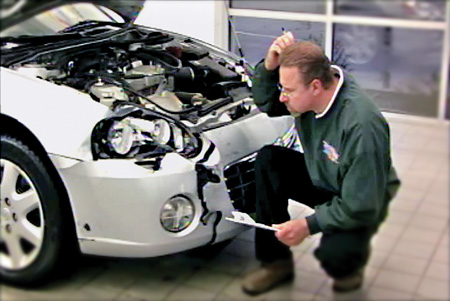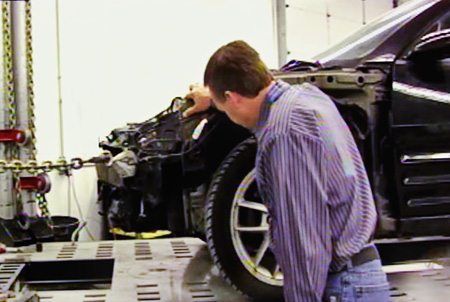
 What may be an up-to-date repair procedure today can quickly become an outdated one tomorrow.
What may be an up-to-date repair procedure today can quickly become an outdated one tomorrow.
Without an easy-to-use single source for correct repair information from vehicle manufacturers, the task of repairing a damaged vehicle to a high and exacting standard will often fall short.
With the abundance of questionable information circulating within the collision repair industry, it’s surprising that damaged vehicles can be repaired to a consistent standard. Accurate information is the key to providing excellent service to customers.
Webster’s Dictionary defines a standard as: “A means of determining what a thing should be. Standard applies to any definite rule, principle or measure established by authority.”
Based on this definition, the following questions should be asked:
- How should things be?
- What are the rules or principles?
- What are the measures?
- Who is the authority?
- Where would I turn to answer these questions?
The bottom line is that vehicle manufacturers are the highest authority for correct repair information, procedures and practices. They design vehicles, develop them, test and deliver them.
Current information-gathering techniques are chaotic, time-consuming, costly and confusing. But this doesn’t have to be the case. Each time you’re faced with a technical problem, ask yourself what it would be like to have access to all of the manufacturers’ published material at a moment’s notice.
Access to accurate and affordable information is a dilemma for insurers as well as repairers. Many body shops are turning to direct-repair programs to enhance revenue and grow business. But as more people become directly involved with repair decisions, the issue of accuracy is even more critical since there is more than one opinion to consider.
Manufacturers’ repair information can take the guesswork out of the picture and lead to a positive outcome and ultimately benefit not only the repair facility but also the insurer.
Estimating
- With factory information available, proper repair methodology will be reflected on the estimate.
- Correct parts will be ordered and replaced due to published manufacturers’ recommendations.
- Proper replacement procedures will be followed, including: full or partial outer/inner panel replacements; full or partial frame components; applicable adhesives, sealants and coatings; and more.
- Accurate factory-correct documentation will eliminate or decrease unnecessary, time-consuming communication.
- Correct documentation will be available to the insurer to validate the repair plan.
- Supplements may be decreased when correct repair procedures are incorporated into the estimate up front, prior to the start of repairs.
- Unrelated prior conditions may be revealed through manufacturers’ technical service bulletins (TSBs) or recalls when the vehicle first comes in.
- The estimate will reflect factory-correct mechanical operations and labor times. This information may not be available to shops and insurers with current estimating systems.
Production
- Correct factory repair documentation will be available to technicians prior to repair processes.
- Factory repair data will be accessible at the time of the teardown, ensuring the correct procedures will be estimated, documented and filed.
- Technicians can access correct, up-to-date procedures, making repairs to current standards with fewer mistakes.
- Access to manufacturers’ repair procedures means fewer damaged or broken parts. Technicians can successfully disassemble parts that may be unfamiliar.
- Constructive negotiations based on correct repair processes can now take place between the insurer and the technician/production manager.
- The production team can access and verify that estimated repair practices are correct.
- TSBs can be accessed to reveal known issues on the vehicle.
- Manufacturers’ procedures can help reduce training for specific repair operations.
- Correct identification and repair methods for advanced steels and other materials can be substantiated.
Business
KPIs will ultimately be enhanced, including:
Cycle Time
- With factory-correct repair information available, correct parts are ordered up front, which means fewer parts returned, less sourcing and minimal downtime.
- Vehicles won’t stop in production due to broken parts, subletting, authorizations, additional and unnecessary supplements and improper repairs.
- Questions can be answered that will affect accurate production criteria:
- Does this vehicle need frame replacement or sectioning?
- Is the damaged area within factory tolerances/dimensions, and can it be straightened?
- Should we sublet this repair or will manufacturers’ information allow us to save time by repairing it in the shop?
- Do we have the correct tools and equipment to repair the vehicle properly?
Efficiencies/Productivity
- Documentation and availability of factory repair procedures prior to production will allow technicians to streamline hands-on repair practices and minimize errors.
- The technician can spend more time working on the vehicle instead of wasting time gathering repair information that may be questionable.
- Shops can perform repairs once outsourced that deal with: suspension and steering operations; electrical systems; hybrid systems; air bags systems; collision avoidance systems.
Overall Average Severity or Cost of Repair
This category is sometimes called the “balance scale.” On one side we have the insurer, which is trying to keep claim severity under control. That, in turn, allows it to pass on the savings to the consumer. On the other side is the collision repairer, whose main goal is to capitalize on gross margins and profitability by cultivating as many sales as possible.
The middle or balanced area would be one where both the insurer and collision repair facility negotiate a cost-effective, accurate and safe agreement that benefits both parties, as well as the customer. Here’s how manufacturers’ repair procedures can help:
- Reduce timely and costly sublet operations by keeping the vehicle in the repair facility: (“I have the instructions to repair this system now.”)
- Reduce rental costs by reducing cycle times: (“I don’t have to stop this vehicle in production and extend rental days because I now have the proper repair plan to keep the repairs moving.”)
- Allow for correct billable repairs: (“I can now show proper factory-published repair steps, charges and documentation that are not available in other systems.”)
- Increased efficiencies and overall productivity: (“My hands are now kept on the vehicle more because I have the proper procedures at the start of repair rather than during it.”)
Customer satisfaction or CSI
Accurate, factory-correct information enhances customer satisfaction:
- "I can explain to my valued customers that we’re repairing their vehicles to OEM repair guidelines.”
- “I can show my customers OEM repair documentation, technical service bulletins and recall information that may help them with other areas of concern on their vehicles.”
- “I can deliver the vehicle to my customers as promised because I’ve reduced time-wasting mistakes thanks to manufacturers’ repair instructions.”
- “I’ve established or enhanced professional credibility with the insurer by providing factory-recommended guidelines and repair techniques.”
- “We’ve conformed to OEM repair guidelines, allowing us to manage liabilities and accurately document the repair.”
Dan Espersen is the ALLDATA Senior Collision Program Manager. He’s a Gold Pin Member of the Collision Industry Conference (CIC) and holds an AA Degree in Automotive Technology. He has 16 years of experience in the collision industry and 17 years of experience in the automotive industry.
© 2008 ALLDATA LLC. All rights reserved. All technical information, images and specifications are from the ALLDATA Product. ALLDATA is a registered trademark and ALLDATA Collision is a mark of
ALLDATA LLC. All other marks are the property of their respective holders.













